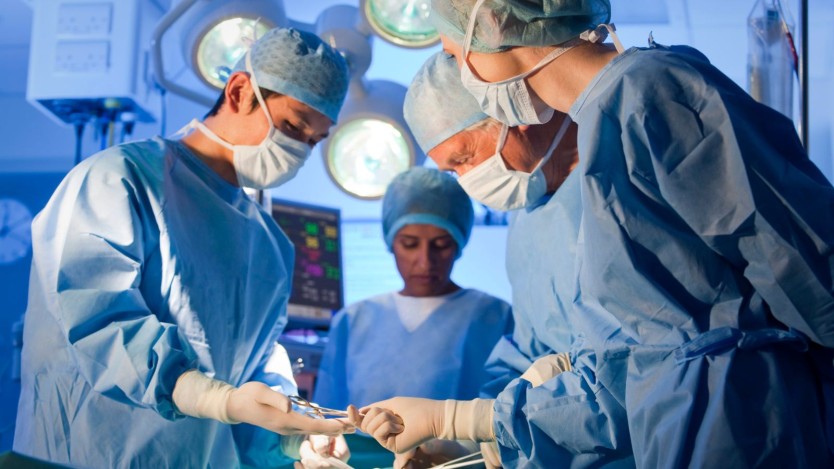Recovery after abdominal hernia surgery

- Recovery after abdominal hernia surgery through conventional surgical treatment
- Recovery after abdominal hernia surgery by laparoscopy
- Abdominal hernia repair interventions are one of the most common operations in the field of general surgery.
- Abdominal hernias can be inguinal, umbilical or epigastric and can be repaired by open surgery or laparoscopy.
- Recovery time after hernia repair surgery varies depending on the size of the hernia and the surgical technique used to repair it.
Hernias appear in the abdominal area when part of the inner wall weakens, allowing a portion of the intestine to slip through this fissure. This is when the so-called hernia "bulge" appears.
Normally this is not a serious problem beyond the discomfort and pain it causes when performing certain activities, but one of the possible complications of a hernia is the strangulation of the part of the intestine that forms the bulge.

Do you need abdominal hernia surgery?
Request a free and immediate appointment with our specialists in general surgery
Because of this compression, the blood does not reach this portion of the intestine, preventing cell renewal from taking place and consequently causing the tissue to die. This will lead to necrosis, infection and serious problems for the patient, so it is vital to repair the hernia to avoid major issues.

There are several types of abdominal hernia that are repaired using the same methods: inguinal hernia, umbilical hernia and epigastric hernia. In terms of postoperative recovery, the repair of one hernia or another does not involve significant changes in time beyond the size of the hernia.
On the other hand, it is the surgical technique used to perform the hernia repair operation that does make a significant difference to postoperative recovery times.
To repair an abdominal hernia, the surgery can be performed using two types of techniques, which we’ll address in the following section.
Recovery after abdominal hernia surgery through conventional surgical treatment
This technique is called hernioplasty. It is the conventional technique for the repair of abdominal hernias. It is performed under spinal or general anaesthesia.
It consists of making an incision of between 5 and 10 cm in the herniated area until the defect is reached.
Once there, the surgeon relocates the portion of intestine involved in the hernia and places a prosthetic mesh in the defective area to prevent the problem from recurring.
The incision is then sutured, a dressing is placed and the patient is taken to the recovery room until he or she recovers from the anaesthesia and vital signs return to normal.
The duration of the conventional hernia repair operation is between 30 to 40 minutes, depending on the patient's characteristics.
Afterwards, you will spend 24 to 48 hours in the hospital where the nursing team will teach you how to take care of yourself to avoid problems during recovery.

Do you need inguinal hernia surgery?
Request a free and immediate appointment with our specialists
Once at home, recovery after conventional hernia surgery takes up to 4 weeks, during which time the patient should avoid heavy physical exertion. After this time, the patient can return to normal daily life.
Recovery after abdominal hernia surgery by laparoscopy
Laparoscopy is a minimally invasive technique that allows hernia repair without the need for open surgery. The use of this technique allows for a shorter recovery, but involves a longer surgical intervention.

Do you need laparoscopic hernia surgery?
Request a free and immediate appointment with our specialists in general surgery
To perform the laparoscopic hernia repair, once the patient is under anaesthesia, the surgeon will make between 3 and 4 mini-incisions in the area near the hernia.
Through these incisions he will introduce a cannula with which he will fill the abdominal cavity with carbon dioxide, which will favour the surgeon's manoeuvrability and visibility.
After this, the laparoscope is introduced through one of the incisions. This consists of a mini-camera with a light connected to a monitor, thanks to which the inside of the abdominal cavity can be observed on a monitor.
The next step is the introduction of the surgical instruments needed to repair the hernia through the remaining incisions.

In this case, the hernia is repaired from the inside. The intestinal tissue that forms the hernia is repositioned and surgical mesh is placed in the defect to prevent it from recurring.
All this is done by the surgeon visualising the interior through the monitor connected to the laparoscope. Nowadays it is possible to do this using 3D technology, which allows the specialist to better perceive the depth and carry out a much safer intervention.
Once the hernia repair is complete, the surgeon will remove all the surgical material and carbon dioxide to take the patient to the resuscitation room until the patient's vital signs are stabilised.
The duration of the procedure ranges from 90 to 120 minutes.
Recovery after this procedure is less than with conventional hernia repair. In this case, the hospital stay can be reduced to a minimum and the patient can leave the hospital on the day of the operation or the following day.
The patient can return to normal daily activities approximately one week after the surgery.
To find out more about these procedures, you can visit these links:
Medical disclaimer: All the published content in Operarme is intended to disseminate reliable medical information to the general public, and is reviewed by healthcare professionals. In any case should this information be used to perform a diagnosis, indicate a treatment, or replace the medical assessment of a professional in a face to face consultation. Find more information in the links below:
